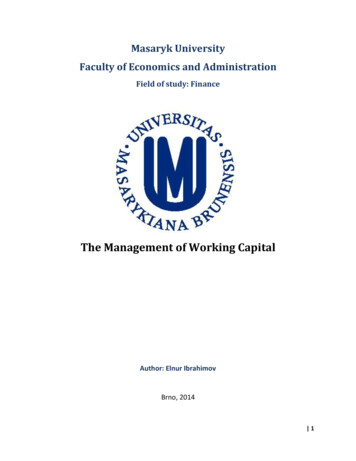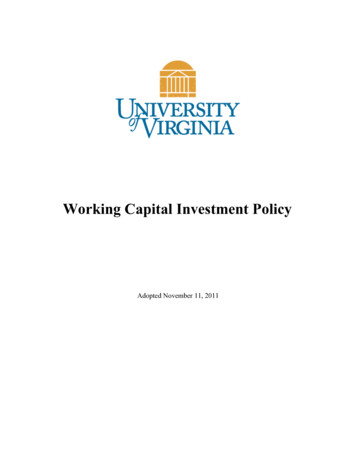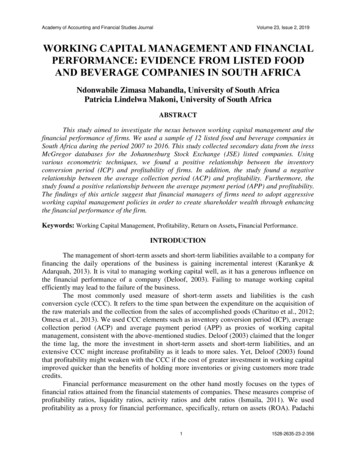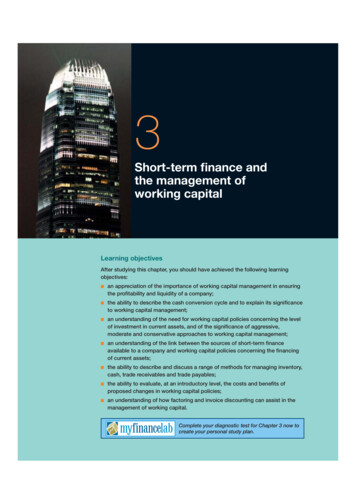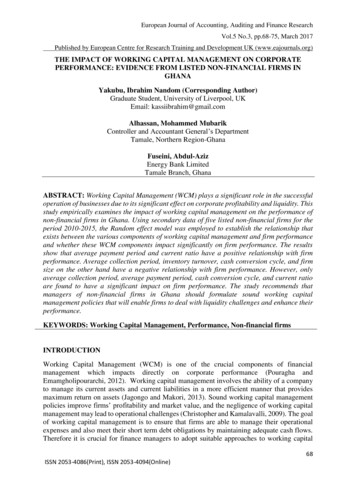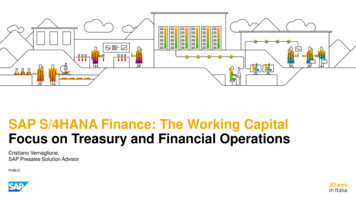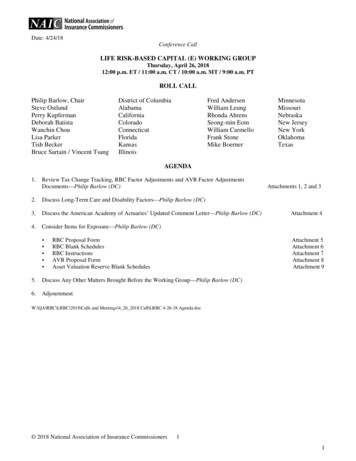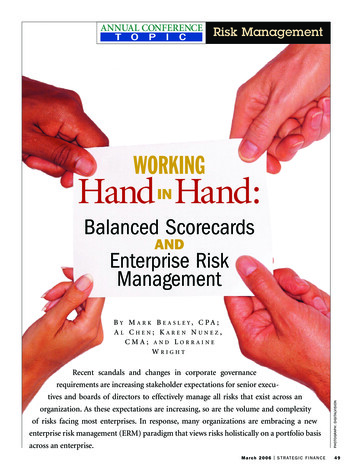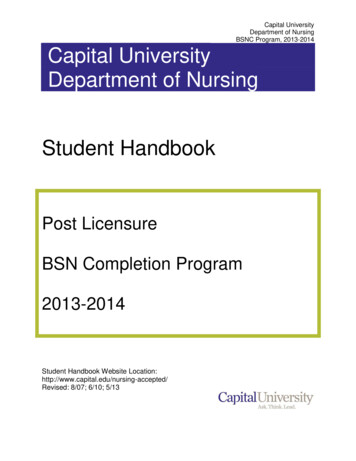
Transcription
WORKING CAPITAL MANAGEMENTVI SEMESTERCORE COURSEBBA(Finance Specialization)(2011 Admission)UNIVERSITY OF CALICUTSCHOOL OF DISTANCE EDUCATIONCALICUT UNIVERSITY P.O., MALAPPURAM, KERALA, INDIA – 673 635320
SCHOOL OF DISTANCE EDUCATIONUNIVERSITY OF CALICUTSCHOOL OF DISTANCE EDUCATIONSTUDY MATERIALCore CourseBBA (Finance Specialization)VI SemesterWORKING CAPITAL MANAGEMENTPrepared by:Scrutinized by:Layout:Sri. Ratheesh .K. Nair,Assistant Professor of Commerce,Department of Commerce,Govt. College, Madappally.Dr. K. Venugopalan,Associate Professor,Department of Commerce,Govt. College, Madappally.Computer Section, SDE ReservedWORKING CAPITAL MANAGEMENTPage 2
SCHOOL OF DISTANCE EDUCATIONMODULECONTENTSPAGE NO.IWORKING CAPITAL5 - 20IIWORKING CAPITAL CYCLE21 - 34IIICASH MANAGEMENT35 - 43IVRECEIVABLES MANAGEMENT44 - 48VINVENTORY MANAGEMENT49 – 55PROBLEMS56 - 58WORKING CAPITAL MANAGEMENTPage 3
SCHOOL OF DISTANCE EDUCATIONWORKING CAPITAL MANAGEMENTPage 4
SCHOOL OF DISTANCE EDUCATIONMODULE-IWORKING CAPITAL Working Capital ConceptsNeed for and components of Working CapitalKinds of Working CapitalDeterminants of Working CapitalEstimation of Working Capital requirementsINTRODUCTION:The uses of funds of a concern can be divided into two parts namely long-term funds andshort-term funds. The long – term investment may be termed as ‘fixed investment.’ A major part ofthe long-term funds is invested in the fixed assets. These fixed assets are retained in the business toearn profits during the life of the fixed assets. To run the business operations short–term assets arealso required.The term working capital is commonly used for the capital required for day-to-day workingin a business concern, such as for purchasing raw material, for meeting day-to-day expenditure onsalaries, wages, rents rates, advertising etc. But there are much disagreement among variousfinancial authorities (Financiers, accountants, businessmen and economists) as to the exact meaningof the term working capital.DEFINITION AND CLASSIFICATION OF WORKING CAPITAL:Working capital refers to the circulating capital required to meet the day to day operationsof a business firm. Working capital may be defined by various authors as follows:1. According to Weston & Brigham - “Working capital refers to a firm’s investment in shortterm assets, such as cash amounts receivables, inventories etc.2. Working capital means current assets. —Mead, Baker and Malott3. “The sum of the current assets is the working capital of the business” —J.S.MillWorking capital is defined as “the excess of current assets over current liabilities andprovisions”. But as per accounting terminology, it is difference between the inflow and outflow offunds. In the Annual Survey of Industries (1961), working capital is defined to include “Stocks ofmaterials, fuels, semi-finished goods including work-in-progress and finished goods and byproducts; cash in hand and bank and the algebraic sum of sundry creditors as represented by(a) outstanding factory payments e.g. rent, wages, interest and dividend;(b) purchase of goods and services;WORKING CAPITAL MANAGEMENTPage 5
SCHOOL OF DISTANCE EDUCATION(c) short-term loans and advances and sundry debtors comprising amounts due to the factory onaccount of sale of goods and services and advances towards tax payments”.The term “working capital” is often referred to “circulating capital” which is frequentlyused to denote those assets which are changed with relative speed from one form to another i.e.,starting from cash, changing to raw materials, converting into work-in-progress and finishedproducts, sale of finished products and ending with realization of cash from debtors.Working capital has been described as the “life blood of any business which is apt becauseit constitutes a cyclically flowing stream through the business”.CONCEPTS OF WORKING CAPITALThere are two concepts of working capital viz. quantitative and qualitative. Some peoplealso define the two concepts as gross concept and net concept. According to quantitative concept,the amount of working capital refers to ‘total of current assets’. Current assets are considered to begross working capital in this concept.The qualitative concept gives an idea regarding source of financing capital. According toqualitative concept the amount of working capital refers to “excess of current assets over currentliabilities.”L.J. Guthmann defined working capital as “the portion of a firm’s current assets which arefinanced from long–term funds.”The excess of current assets over current liabilities is termed as ‘Net working capital’. Inthis concept “Net working capital” represents the amount of current assets which would remain ifall current liabilities were paid. Both the concepts of working capital have their own points ofimportance. “If the objectives is to measure the size and extent to which current assets are beingused, ‘Gross concept’ is useful; whereas in evaluating the liquidity position of an undertaking ‘Netconcept’ becomes pertinent and preferable.It is necessary to understand the meaning of current assets and current liabilities forlearning the meaning of working capital, which is explained below.Current assets – It is rightly observed that “Current assets have a short life span. These typesof assets are engaged in current operation of a business and normally used for short– termoperations of the firm during an accounting period i.e. within twelve months. The two importantcharacteristics of such assets are,(i) Short life span, and(ii) Swift transformation into other form of assets.Cash balance may be held idle for a week or two, account receivable may have a life spanof 30 to 60 days, and inventories may be held for 30 to 100 days.”Fitzgerald defined current assets as, “cash and other assets which are expected to beconverted in to cash in the ordinary course of business within one year or within such longer periodas constitutes the normal operating cycle of a business.”Current liabilities – The firm creates a Current Liability towards creditors (sellers) fromwhom it has purchased raw materials on credit. This liability is also known as accounts payable andshown in the balance sheet till the payment has been made to the creditors.WORKING CAPITAL MANAGEMENTPage 6
SCHOOL OF DISTANCE EDUCATIONThe claims or obligations which are normally expected to mature for payment within anaccounting cycle are known as current liabilities. These can be defined as “those liabilities whereliquidation is reasonably expected to require the use of existing resources properly classifiable ascurrent assets, or the creation of other current assets, or the creation of other current liabilities.”Circulating capital – working capital is also known as ‘circulating capital or current capital.’“The use of the term circulating capital instead of working capital indicates that its flow is circularin nature.”STRUCTURE OF WORKING CAPITALThe different elements or components of current assets and current liabilities constitute thestructure of working capital which can be illustrated in the shape of a chart as follows:STRUCTURE OF CURRENT ASSETS AND CURRENT LIABILITIESCurrent LiabilitiesBank OverdraftCreditorsOutstanding ExpensesBills PayableShort-term LoansProposed DividendsProvision for Taxation, etcCurrent AssetsCash and Bank BalanceInventories: Raw-MaterialsWork-in-progressFinished GoodsSpare PartsAccounts ReceivablesBills ReceivablesAccrued IncomePrepaid ExpensesShort-term InvestmentsCIRCULATION OF WORKING CAPITALAt one given time both the current assets and current liabilities exist in the business. Thecurrent assets and current liabilities are flowing round in a business like an electric current.However, “The working capital plays the same role in the business as the role of heart in humanbody. Working capital funds are generated and these funds are circulated in the business. As andwhen this circulation stops, the business becomes lifeless. It is because of this reason that heworking capital is known as the circulating capital as it circulates in the business just like blood inthe human body.”1. Gross Working Capital: It refers to the firm’s investment in total current or circulating assets.2. Net Working Capital:The term “Net Working Capital” has been defined in two different ways:i. It is the excess of current assets over current liabilities. This is, as a matter of fact, themost commonly accepted definition. Some people define it as only the differencebetween current assets and current liabilities. The former seems to be a better definitionas compared to the latter.ii. It is that portion of a firm’s current assets which is financed by long-term funds.3. Permanent Working Capital: This refers to that minimum amount of investment in all currentassets which is required at all times to carry out minimum level of business activities. In otherWORKING CAPITAL MANAGEMENTPage 7
SCHOOL OF DISTANCE EDUCATIONwords, it represents the current assets required on a continuing basis over the entire year. TandonCommittee has referred to this type of working capital as “Core current assets”.Working Capital may be classified in two ways (Kinds of Working Capital)a) Concept based working capitalb) Time based working capitalc) Classification on the basis of financial reports.CONCEPT BASED WORKING CAPITAL1. Gross Working Capital2. Net Working Capital3. Negative Working CapitalCONCEPTS OF WORKING CAPITAL1. Gross Working Capital: It refers to the firm’s investment in total current or circulating assets.2. Net Working Capital:The term “Net Working Capital” has been defined in two different ways:i.It is the excess of current assets over current liabilities. This is, as a matter of fact, themost commonly accepted definition. Some people define it as only the differencebetween current assets and current liabilities. The former seems to be a better definitionas compared to the latter.ii.It is that portion of a firm’s current assets which is financed by long-term funds.3. Negative Working Capital: This situation occurs when the current liabilities exceed the currentassets. It is an indication of crisis to the firm.TIME BASED WORKING CAPITAL1. Permanent or Fixed Working Capital(a) Regular Working Capital(b) Reserve Working Capital2. Temporary or Variable Working Capital(a) Seasonal Working Capital(b) Special Working Capital1. Permanent Working Capital: This refers to that minimum amount of investment in all currentassets which is required at all times to carry out minimum level of business activities. In otherwords, it represents the current assets required on a continuing basis over the entire year. TandonCommittee has referred to this type of working capital as “Core current assets”.The following are the characteristics of this type of working capital:WORKING CAPITAL MANAGEMENTPage 8
SCHOOL OF DISTANCE EDUCATION1.Amount of permanent working capital remains in the business in one form or another. Thisis particularly important from the point of view of financing. The suppliers of such workingcapital should not expect its return during the life-time of the firm.2.It also grows with the size of the business. In other words, greater the size of the business,greater is the amount of such working capital and vice versa Permanent working capital ispermanently needed for the business and therefore it should be financed out of long-termfunds.2. Temporary Working Capital: The amount of such working capital keeps on fluctuating fromtime to time on the basis of business activities. In other words, it represents additional currentassets required at different times during the operating year. For example, extra inventory has to bemaintained to support sales during peak sales period. Similarly, receivable also increase and mustbe financed during period of high sales. On the other hand investment in inventories, receivables,etc., will decrease in periods of depression.Suppliers of temporary working capital can expect its return during off season when it is notrequired by the firm. Hence, temporary working capital is generally financed from short- termsources of finance such as bank credit.Classification on the basis of financial reports – The information of working capital can becollected from Balance Sheet or Profit and Loss Account; as such the working capital may beclassified as follows:(i) Cash Working Capital – This is calculated from the information contained in profit andloss account. This concept of working capital has assumed a great significance in recent years as itshows the adequacy of cash flow in business. It is based on ‘Operating Cycle Concept’.(ii) Balance Sheet Working Capital – The data for Balance Sheet Working Capital iscollected from the balance sheet. On this basis the Working Capital can also be divided in threemore types, viz., gross Working Capital, net Working Capital and Working Capital deficit.NEED FOR AND COMPONENTS OF WORKING CAPITALFor smooth running an enterprise, adequate amount of working capital is very essential.Efficiency in this area can help, to utilize fixed assets gainfully, to assure the firm’s long- termsuccess and to achieve the overall goal of maximization of the shareholders, fund. Shortage or badmanagement of cash may result in loss of cash discount and loss of reputation due to non-paymentof obligation on due dates. Insufficient inventories may be the main cause of production held upand it may compel the enterprises to purchase raw materials at unfavourable rates.Like-wise facility of credit sale is also very essential for sales promotions. It is rightlyobserved that “many a times business failure takes place due to lack of working capital.” Adequateworking capital provides a cushion for bad days, as a concern can pass its period of depressionwithout much difficulty.O’ Donnel correctly explained the significance of adequate working capital and mentionedthat “to avoid interruption in the production schedule and maintain sales, a
Working capital refers to the circulating capital required to meet the day to day operations of a business firm. Working capital may be defined by various authors as follows: 1. According to Weston & Brigham - “Working capital refers to a firm’s investment in short term assets, such as cash amounts receivables, inventories etc. 2. Working capital means current assets. —Mead, Baker and Malott
